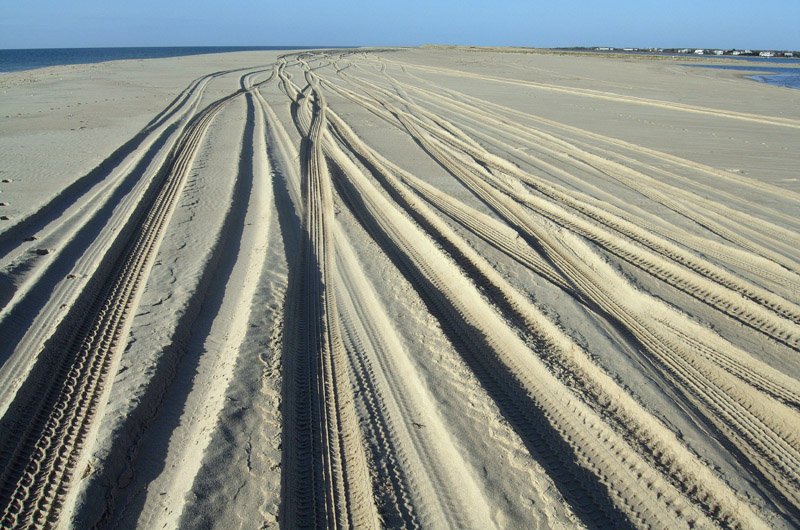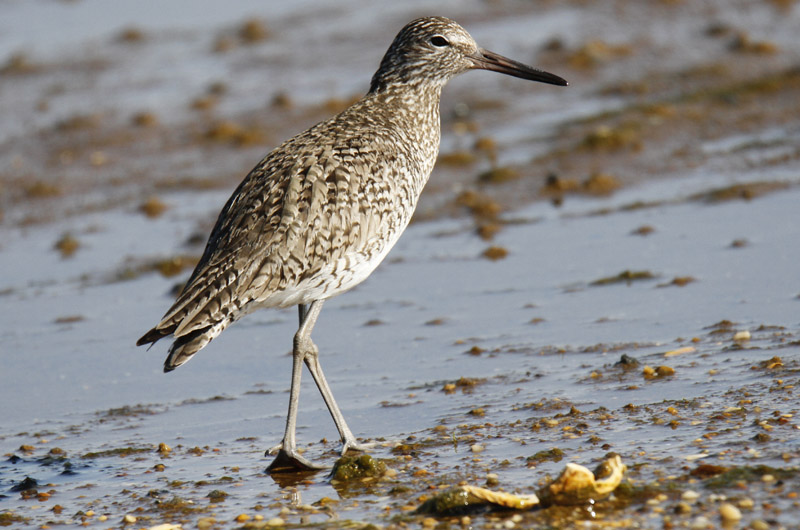Fences and signs have sprung up on Chappaquiddick as the annual brood of plovers and terns begins to hatch. To comply with state and federal guidelines, The Trustees of Reservations closed all of Cape Pogue to over-sand vehicle traffic this week. Dogs are also prohibited on the beach.

Shorebird protection programs have been in place at Cape Pogue for decades. But this year’s closure, while not unexpected, has fueled the concerns of local fishermen who have been enjoying one of the best bluefish runs on Chappaquiddick in years.
“As they get more birds it gets worse and worse and worse,” said Cooper Gilkes, owner of Coop’s Bait in Tackle in Edgartown, a popular stop for Island surfcasters. Business at Coop’s picked up this year with the restoration of Wasque Point, on the south shore of Chappaquiddick, which was severely breached during a storm in 2007.
Two weekends ago, dozens of vehicles and fishermen lined the beach, where newly restored rip currents were teaming with bluefish. After a few slower days last week, the bluefish are running again, but so are the plovers, and many fishermen feel sidelined. On Wednesday, a dozen trucks were parked at Wasque, as people relaxed in lawn chairs or silently cast into the surf. Riding over the sand in his pickup truck, Mr. Gilkes pointed out the circular fences surrounding new plover nests. “When these things hatch, there goes your beach,” he said. The line of trucks stopped at Wasque Point, where Leland Beach continues north along Cape Pogue.
The closures allow for continued foot traffic near the water, but many fishermen say they depend on vehicles to access Norton Point and the remote beaches around Cape Pogue.
“You’re not going to walk very far in heavy waders,” said Harry Taylor, who earlier in the day was at Coop’s to pick up some gear. Mr. Taylor also questioned the practice of selling over-sand permits for beaches that are closed.
Mr. Gilkes said tackle shops from here to Maine are suffering from the closures. “We are doing all right,” he said. “But there’s people that are going borderline and then the next thing you know it’s too late and nobody is there to throw a rope to them.”
Shorebird protection efforts began in the 1980s, and by the 1990s had spread across the Island. Today several environmental groups, including the Martha’s Vineyard Land Bank, Mass Audubon, BiodiversityWorks and the Sheriff’s Meadow Foundation, monitor five shorebird species, including American oystercatchers and three species of tern.
By most accounts, the efforts have been a major success. From 1990 to 1994, the number of piping plover pairs increased from 22 to more than 50. There are now about 60 pairs on the Island, and more than 600 in the state.
Susi von Oettingen, an endangered species biologist for the U.S. Fish and Wildlife Service, said the number of plover pairs in the state has exceeded the New England recovery goal of 625. By comparison, she said, Rhode Island has about 70 pairs and Connecticut has less than 50. Plovers are currently listed as a threatened species.
Martha’s Vineyard is something of a model, she said: “You have a number of unbelievably cooperative land owners and organizations . . . that really manage the habitat and the birds to the maximum extent. It’s really, really impressive.”
But more work is needed to reach the state goal of 1.24 chicks per pair. On Chappy, the average is .88. Eventually, the guidelines for protection will become more flexible, biologists said. But the monitoring will continue.
“You can’t just delist [the birds] because then they will just be right back where they were,” said BiodiversityWorks director Luanne Johnson, who oversees about 15 shorebird nesting sites on the Island.
BiodiversityWorks spends between $28,000 and $33,000 per year to monitor shorebirds. The costs are covered by grants and donations, which Ms. Johnson said indicates strong public support for the program.
Caitlin Borck, an ecologist for The Trustees of Reservations, manages the shorebird program on Chappaquiddick. “This year we have exclosed almost every single one of our piping plover nests and they are all quickly hatching this week,” she said Monday. She counted 11 pairs in all, including four on Leland Beach. As one promising sign for fishermen, she said, most of the plovers nested within a week of each other, which means they will hatch at around the same time. “So hopefully these closures will open up just as quickly as they closed,” she said.
Later in the season, Norton Point Beach will almost certainly close as terns begin to hatch. That’s often more of a wild card, Ms. Borck said, since the terns there tend to nest at different times.
In the case of plovers, the beach may reopen only after the chicks are 35 days old, or have demonstrated the ability to fly continuously for 50 feet.
Ms. Borck said plover chicks are extremely vulnerable. “They are just little puff balls that are the same color as the sand,” she said. When threatened, adults let out a call and the chicks hunker down in the sand without moving, even in the path of an oncoming vehicle. “The vehicle will just run them over,” Ms. Borck said. “They won’t move. And even if they did move, they are so small that somebody in a truck up high isn’t necessarily going to see them.”
Mr. Gilkes has another viewpoint. “We have nothing against the birds,” he said. “It’s the program.” He also emphasized that most fishermen understand that biologists are simply doing their job. But at the same time, he said, most fishermen are fed up with the regulations. As one alternative, he suggested assigning one monitor for each chick and allowing for continued vehicle access. He also raised concern about kids growing up on the Island and losing touch with the culture of fishing.
“You’ve got kids right now sitting in front of TVs . . . when they should be out on the beach,” Mr. Gilkes said. “And all we’re doing is closing our beaches for the birds. Does that make sense?”
Donald Scarpone, president of the Martha’s Vineyard Surfcasters Association, was relaxing beside his truck Wednesday, as the surf rolled in at Norton Point. He agreed with Mr. Gilkes that the shorebird program was unfair and that closures are avoidable. He said nearly all 120 members of the surfcasters felt the same way. “We are out here to enjoy life and enjoy the fishery and we can’t,” he said. “The beaches get closed and everybody gets mad about it, and it’s over a little bird.”
He added that the closures this year were earlier and more abundant than in the past. But with only 120 members, he believed the surfcasters would be powerless to bring about changes at the state level.
The state does allow for some flexibility in areas that have reached their restoration goals, said Ms. von Oettingen. But that also comes at a cost. “The more flexibility you want, the more you are going to have to have intensive management,” she said. “And that means daily monitoring.” She noted that the town of Orleans has a three-year plan that allows for some limited off-road vehicle access.
Mr. Gilkes recalled the days when he could drive unrestricted on Island beaches. Now only Norton Point and Cape Pogue allow over-sand vehicles. “You would think that they would give a little on these particular two beaches because you can’t go anyplace else on the Island,” he said.
But some fishermen are more resigned to the closures. Jeffrey Canha, owner of Done Deal Charters in Vineyard Haven, said Island charter companies have actually benefitted from the increased demand for boat fishing. He saw no problem with the closures, as long as they didn’t last too long.
Fisherman Kib Bramhall walks to almost all of his fishing spots, but sympathized with his friends who drive to the Chappaquiddick beaches.
“Chappaquiddick is really the jewel of Vineyard fishing from shore,” he said. “And yes, there are many other places on the Island which are accessible by foot where you can catch striped bass and bluefish. Perhaps they are not as good as Chappaquiddick, however.”
Meanwhile, the Trustees are working to maintain a balance between beachgoing and shorebird protection. As one example, they have worked with the state to allow secondary access to Norton Point during closures. In regard to complaints from the public, Ms. Borck said: “We try to hear them out and make concessions where we can. We just legally can’t always do anything.”








Comments (8)
Comments
Comment policy »